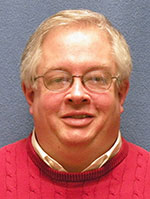Faith and Family / Sean Gallagher
Heaven and Earth come together in Catholic cemeteries
 Visiting cemeteries is something that Catholics do a good bit at this time of year. All Souls Day on Nov. 2 is a feast in which we’re especially encouraged to pray for the souls in purgatory.
Visiting cemeteries is something that Catholics do a good bit at this time of year. All Souls Day on Nov. 2 is a feast in which we’re especially encouraged to pray for the souls in purgatory.
The Church offers this invitation in part through a plenary indulgence that can be gained for any deceased person during the first week of November.
To gain the indulgence, a person has to visit a cemetery and pray there (or at least pray for the deceased mentally) and visit a church and pray an Our Father and the creed. And as with any plenary indulgence, a person also has to be completely detached from sin, have sacramentally confessed his or her sins, received Communion and prayed for the intentions of the pope.
In addition to the great good of helping our beloved dead—or anyone who is deceased—to be welcomed into heaven, visiting parish cemeteries or Catholic cemeteries in cities that serve several faith communities can be like a family reunion.
I grew up in St. Joseph Parish in Shelbyville. And when I visit its cemetery and pause before the gravestones of my mom and my paternal grandparents, my memories of these loved ones become so vivid that it’s almost like they’re right there with me.
And, in a real way, they are. Since its earliest days, the Church has understood itself as the mystical body of Christ extending without break from heaven to Earth. Through the grace of God, all of the faithful in a state of grace, both living and dead, are in complete communion with the Lord.
Visiting cemeteries, where the bodily remains of faithful are laid to rest, in a sense, puts flesh and bones on this Church teaching that might otherwise seem abstract and separated from our daily lives.
And that’s been the case throughout Church history. The Christians who lived in the Roman Empire distinguished themselves from the pagans of their day by this belief.
Our forebears in the faith saw the graves of the saints as places where heaven and Earth literally came together. The physical life of the Church came to be centered on these graves, with major churches, like St. Peter’s Basilica at the Vatican and its ancient predecessor being built over the top of them.
Pagans, in contrast, believed that there was an unbridgeable gulf separating the dead from the living. This belief was reflected in the fact that their cemeteries were placed on the edge of towns, outside of their city walls.
Now I don’t foresee a huge basilica being built anytime soon over St. Joseph’s cemetery. But that doesn’t mean that it’s still not a place where saints are buried.
I have a Christian hope based in faith that my loved ones are either in heaven or will be there one day. And I believe that’s also the case with so many parishioners and priests buried there whom I’ve known over the years. They’re all part of my family of faith.
Walking slowly by their graves brings back many memories of them. It also brings to life stories I’ve heard about those whom I never had the chance to meet in this life, like my great-great grandfather John Peter Gallagher, who came to Indiana from his native Ireland some 150 years ago and who was laid to rest at St. Joseph Cemetery.
So, there’s no unbridgeable gulf separating all of these wonderful men and women of faith from me as I seek to follow in their footsteps. And that’s all thanks to our loving God who desires to draw all of his children into one family of faith. †
 Visiting cemeteries is something that Catholics do a good bit at this time of year. All Souls Day on Nov. 2 is a feast in which we’re especially encouraged to pray for the souls in purgatory.
Visiting cemeteries is something that Catholics do a good bit at this time of year. All Souls Day on Nov. 2 is a feast in which we’re especially encouraged to pray for the souls in purgatory.